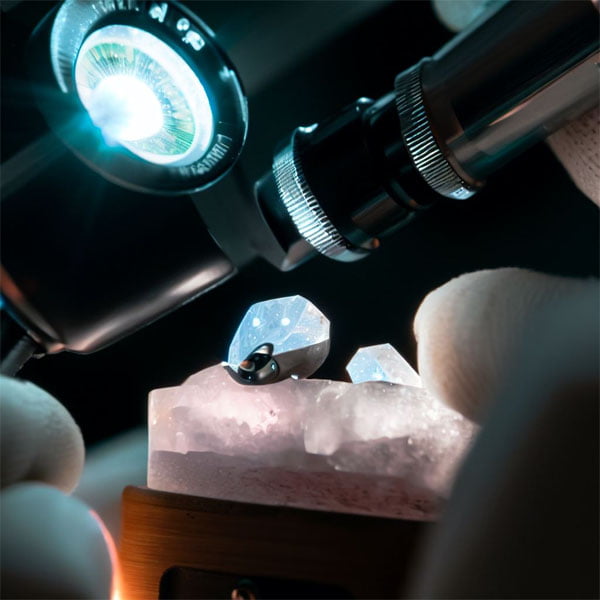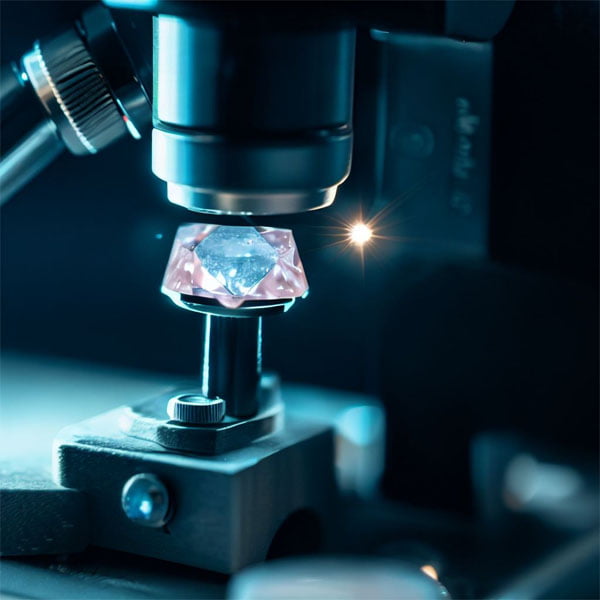Have you ever wondered how that sparkling jewel on your finger was deemed authentic? Or, what secret methods are at play when you purchase a gemstone at Hatton Garden, assuring you it’s the real deal? You’re not alone, and it’s a question well worth asking in a world where fake gems are becoming ever so sophisticated. When you’re spending potentially thousands on a gemstone, the last thing you want is to be handed a counterfeit.
This in-depth piece aims to unveil the mysteries behind gemstone authentication and how refractometers, in particular, have become the go-to instruments in gemology. By the time you reach the end of this article, you’ll know why refractometers have become the shining stars of gemstone authentication.
The Basic Science: How Do Refractometers Work?
Picture this: a detective in a lab coat scrutinising a beautiful sapphire under a tiny device, her eyes keenly focused. What she’s using is a refractometer, a rather nifty device that measures the angle at which light passes through a gemstone. Simplifying the jargon, it tells us how much the gem bends light, otherwise known as its refractive index.
When you place a gem on a refractometer’s prism, a light source beams through it. The angle at which this light emerges allows the refractometer to measure the gem’s refractive index. This is an excellent first step in identifying what kind of gem it is.
Fun Fact: Did you know that no two types of gemstones have the same refractive index? This makes refractometers incredibly effective in initial gem identification!
The Limits of Refractometers
However, while refractometers are undoubtedly effective and accurate, they aren’t all-powerful. For example, they can’t identify certain synthetic gems. But don’t let that knock your confidence in them; they still serve as a fantastic starting point for gem authentication.
The Old But Gold: Mineral Hardness Tests
If you’ve been scratching your head (pun intended) about how hard your gemstone is, the Mohs scale is what you need to look into. Think of it as a toughness ladder for gems. Mineral hardness tests, like those that use the Mohs scale, involve scratching a gemstone with a known mineral to gauge its resistance to scratching.
Although these tests are not as precise as refractometers, they are essential in gemology. That’s because they’re cheap, easy, and quick to perform. If you have a gem that scratches talc but not gypsum, you can place it somewhere between these two on the Mohs scale.
Hatton Garden: The UK Hub for Gemstone Authentication
For Brits looking to buy authentic gemstones, Hatton Garden in London is the place to visit. However, make sure you don’t just rely on the word of the seller. Have your gem verified by a qualified gemologist. These experts use a combination of methods—from refractometers to mineral hardness tests—to certify a gemstone’s authenticity.


Renowned Companies offering Gemmological Certification Services
When it comes to gemstone authentication, three prominent laboratories stand out, each renowned for their expertise and commitment to upholding the authenticity and quality of precious gemstones. Among them, the British Gemological Institute (BGI) shines as a beacon of trust and excellence in the field.
British Gemological Institute (BGI): As a cornerstone of the British gemological landscape, the BGI is celebrated for its rigorous standards and unwavering dedication to precision. Established in the heart of London, this esteemed institution has earned its place among the best due to its cutting-edge technology and a team of highly skilled gemologists. BGI’s proficiency extends to utilising refractometers as a primary tool for measuring mineral hardness. Their ability to provide accurate and reliable gemstone authentication has made them a global leader in the industry. With a rich history dating back decades, the BGI continues to maintain its status as a trusted authority, offering comprehensive services for gemstone enthusiasts and professionals alike.
Gemological Institute of America (GIA): Crossing the Atlantic, the Gemological Institute of America, headquartered in Carlsbad, California, deserves a prominent spot on the list of top gemstone authentication laboratories. The GIA’s global reputation is underpinned by its unwavering commitment to research, education, and innovation. Their state-of-the-art laboratories utilise advanced refractometers and an array of other cutting-edge tools to assess the authenticity and quality of gemstones. The GIA’s extensive research and contributions to gemology have elevated its standing in the industry, making it a preferred choice for gemstone enthusiasts and traders worldwide.
Swiss Gemological Laboratory (SGL): Nestled in the heart of Europe, the Swiss Gemological Laboratory (SGL) is a powerhouse of gemstone authentication. This Swiss institution boasts a strong presence in the world of gemology, offering services that adhere to the highest standards of precision and reliability. SGL is a noteworthy addition to the list for its dedication to technological advancement, incorporating the use of refractometers and other modern equipment for accurate mineral hardness measurement. With a focus on customer satisfaction and comprehensive gemstone reports, SGL has earned its place among the best in the field.
Alternatives in Gemstone Identification
Beyond refractometers and mineral hardness tests, other methods are also popular for gem identification. Techniques like polariscope tests, microscope tests, and even X-ray fluorescence can be used. These alternative approaches can offer additional insights into a gemstone, serving as a secondary or complementary means of authentication.
Conclusion: The Undisputed Value of Refractometers in Gemstone Authentication
So, what’s the takeaway? Refractometers have set themselves apart as crucial devices in gemology. They’re not just handy gadgets but indispensable tools in the quest for unmasking the true identity of a gemstone. While they do have their limitations and can’t work magic for every single type of gem, their contribution to gems authentication is pivotal.
And let’s not forget their sidekicks: mineral hardness tests and other various techniques. These are the guardians that collectively ensure you’re getting the real treasure, not some clever imitation.
So, the next time you find yourself at Hatton Garden or any other place selling gemstones, take a moment to appreciate the intricate science and skill that goes into making sure that shiny rock is worth every penny. After all, knowing is half the battle.
- How do refractometers work in gemstone authentication? Refractometers measure how gems bend light to determine authenticity.
- Can refractometers identify all types of gemstones? No, they can’t. Some synthetics may require additional tests.
- Where is Hatton Garden, and why is it famous for gems? Hatton Garden is in London, renowned for authentic gemstones.
- How do mineral hardness tests help in gem authentication? They gauge a gem’s resistance to scratching, aiding identification.
- Are other methods used besides refractometers? Yes, techniques like polariscope tests and microscopy complement authentication.



